Archit Sharma
FSPO: Few-Shot Preference Optimization of Synthetic Preference Data in LLMs Elicits Effective Personalization to Real Users
Feb 26, 2025Abstract:Effective personalization of LLMs is critical for a broad range of user-interfacing applications such as virtual assistants and content curation. Inspired by the strong in-context learning capabilities of LLMs, we propose Few-Shot Preference Optimization (FSPO), which reframes reward modeling as a meta-learning problem. Under this framework, an LLM learns to quickly adapt to a user via a few labeled preferences from that user, constructing a personalized reward function for them. Additionally, since real-world preference data is scarce and challenging to collect at scale, we propose careful design choices to construct synthetic preference datasets for personalization, generating over 1M synthetic personalized preferences using publicly available LLMs. In particular, to successfully transfer from synthetic data to real users, we find it crucial for the data to exhibit both high diversity and coherent, self-consistent structure. We evaluate FSPO on personalized open-ended generation for up to 1,500 synthetic users across across three domains: movie reviews, pedagogical adaptation based on educational background, and general question answering, along with a controlled human study. Overall, FSPO achieves an 87% Alpaca Eval winrate on average in generating responses that are personalized to synthetic users and a 72% winrate with real human users in open-ended question answering.
Test-Time Alignment via Hypothesis Reweighting
Dec 11, 2024Abstract:Large pretrained models often struggle with underspecified tasks -- situations where the training data does not fully define the desired behavior. For example, chatbots must handle diverse and often conflicting user preferences, requiring adaptability to various user needs. We propose a novel framework to address the general challenge of aligning models to test-time user intent, which is rarely fully specified during training. Our approach involves training an efficient ensemble, i.e., a single neural network with multiple prediction heads, each representing a different function consistent with the training data. Our main contribution is HyRe, a simple adaptation technique that dynamically reweights ensemble members at test time using a small set of labeled examples from the target distribution, which can be labeled in advance or actively queried from a larger unlabeled pool. By leveraging recent advances in scalable ensemble training, our method scales to large pretrained models, with computational costs comparable to fine-tuning a single model. We empirically validate HyRe in several underspecified scenarios, including personalization tasks and settings with distribution shifts. Additionally, with just five preference pairs from each target distribution, the same ensemble adapted via HyRe outperforms the prior state-of-the-art 2B-parameter reward model accuracy across 18 evaluation distributions.
Policy Agnostic RL: Offline RL and Online RL Fine-Tuning of Any Class and Backbone
Dec 09, 2024Abstract:Recent advances in learning decision-making policies can largely be attributed to training expressive policy models, largely via imitation learning. While imitation learning discards non-expert data, reinforcement learning (RL) can still learn from suboptimal data. However, instantiating RL training of a new policy class often presents a different challenge: most deep RL machinery is co-developed with assumptions on the policy class and backbone, resulting in poor performance when the policy class changes. For instance, SAC utilizes a low-variance reparameterization policy gradient for Gaussian policies, but this is unstable for diffusion policies and intractable for autoregressive categorical policies. To address this issue, we develop an offline RL and online fine-tuning approach called policy-agnostic RL (PA-RL) that can effectively train multiple policy classes, with varying architectures and sizes. We build off the basic idea that a universal supervised learning loss can replace the policy improvement step in RL, as long as it is applied on "optimized" actions. To obtain these optimized actions, we first sample multiple actions from a base policy, and run global optimization (i.e., re-ranking multiple action samples using the Q-function) and local optimization (i.e., running gradient steps on an action sample) to maximize the critic on these candidates. PA-RL enables fine-tuning diffusion and transformer policies with either autoregressive tokens or continuous action outputs, at different sizes, entirely via actor-critic RL. Moreover, PA-RL improves the performance and sample-efficiency by up to 2 times compared to existing offline RL and online fine-tuning methods. We show the first result that successfully fine-tunes OpenVLA, a 7B generalist robot policy, autonomously with Cal-QL, an online RL fine-tuning algorithm, improving from 40% to 70% in the real world in 40 minutes.
Grounding by Trying: LLMs with Reinforcement Learning-Enhanced Retrieval
Oct 31, 2024Abstract:The hallucinations of large language models (LLMs) are increasingly mitigated by allowing LLMs to search for information and to ground their answers in real sources. Unfortunately, LLMs often struggle with posing the right search queries, especially when dealing with complex or otherwise indirect topics. Observing that LLMs can learn to search for relevant facts by $\textit{trying}$ different queries and learning to up-weight queries that successfully produce relevant results, we introduce $\underline{Le}$arning to $\underline{Re}$trieve by $\underline{T}$rying (LeReT), a reinforcement learning framework that explores search queries and uses preference-based optimization to improve their quality. LeReT can improve the absolute retrieval accuracy by up to 29% and the downstream generator evaluations by 17%. The simplicity and flexibility of LeReT allows it to be applied to arbitrary off-the-shelf retrievers and makes it a promising technique for improving general LLM pipelines. Project website: http://sherylhsu.com/LeReT/.
Towards Data-Centric RLHF: Simple Metrics for Preference Dataset Comparison
Sep 15, 2024Abstract:The goal of aligning language models to human preferences requires data that reveal these preferences. Ideally, time and money can be spent carefully collecting and tailoring bespoke preference data to each downstream application. However, in practice, a select few publicly available preference datasets are often used to train reward models for reinforcement learning from human feedback (RLHF). While new preference datasets are being introduced with increasing frequency, there are currently no existing efforts to measure and compare these datasets. In this paper, we systematically study preference datasets through three perspectives: scale, label noise, and information content. We propose specific metrics for each of these perspectives and uncover different axes of comparison for a better understanding of preference datasets. Our work is a first step towards a data-centric approach to alignment by providing perspectives that aid in training efficiency and iterative data collection for RLHF.
Preference Fine-Tuning of LLMs Should Leverage Suboptimal, On-Policy Data
Apr 23, 2024



Abstract:Learning from preference labels plays a crucial role in fine-tuning large language models. There are several distinct approaches for preference fine-tuning, including supervised learning, on-policy reinforcement learning (RL), and contrastive learning. Different methods come with different implementation tradeoffs and performance differences, and existing empirical findings present different conclusions, for instance, some results show that online RL is quite important to attain good fine-tuning results, while others find (offline) contrastive or even purely supervised methods sufficient. This raises a natural question: what kind of approaches are important for fine-tuning with preference data and why? In this paper, we answer this question by performing a rigorous analysis of a number of fine-tuning techniques on didactic and full-scale LLM problems. Our main finding is that, in general, approaches that use on-policy sampling or attempt to push down the likelihood on certain responses (i.e., employ a "negative gradient") outperform offline and maximum likelihood objectives. We conceptualize our insights and unify methods that use on-policy sampling or negative gradient under a notion of mode-seeking objectives for categorical distributions. Mode-seeking objectives are able to alter probability mass on specific bins of a categorical distribution at a fast rate compared to maximum likelihood, allowing them to relocate masses across bins more effectively. Our analysis prescribes actionable insights for preference fine-tuning of LLMs and informs how data should be collected for maximal improvement.
Stream of Search : Learning to Search in Language
Apr 01, 2024Abstract:Language models are rarely shown fruitful mistakes while training. They then struggle to look beyond the next token, suffering from a snowballing of errors and struggling to predict the consequence of their actions several steps ahead. In this paper, we show how language models can be taught to search by representing the process of search in language, as a flattened string -- a stream of search (SoS). We propose a unified language for search that captures an array of different symbolic search strategies. We demonstrate our approach using the simple yet difficult game of Countdown, where the goal is to combine input numbers with arithmetic operations to reach a target number. We pretrain a transformer-based language model from scratch on a dataset of streams of search generated by heuristic solvers. We find that SoS pretraining increases search accuracy by 25% over models trained to predict only the optimal search trajectory. We further finetune this model with two policy improvement methods: Advantage-Induced Policy Alignment (APA) and Self-Taught Reasoner (STaR). The finetuned SoS models solve 36% of previously unsolved problems, including problems that cannot be solved by any of the heuristic solvers. Our results indicate that language models can learn to solve problems via search, self-improve to flexibly use different search strategies, and potentially discover new ones.
Yell At Your Robot: Improving On-the-Fly from Language Corrections
Mar 19, 2024Abstract:Hierarchical policies that combine language and low-level control have been shown to perform impressively long-horizon robotic tasks, by leveraging either zero-shot high-level planners like pretrained language and vision-language models (LLMs/VLMs) or models trained on annotated robotic demonstrations. However, for complex and dexterous skills, attaining high success rates on long-horizon tasks still represents a major challenge -- the longer the task is, the more likely it is that some stage will fail. Can humans help the robot to continuously improve its long-horizon task performance through intuitive and natural feedback? In this paper, we make the following observation: high-level policies that index into sufficiently rich and expressive low-level language-conditioned skills can be readily supervised with human feedback in the form of language corrections. We show that even fine-grained corrections, such as small movements ("move a bit to the left"), can be effectively incorporated into high-level policies, and that such corrections can be readily obtained from humans observing the robot and making occasional suggestions. This framework enables robots not only to rapidly adapt to real-time language feedback, but also incorporate this feedback into an iterative training scheme that improves the high-level policy's ability to correct errors in both low-level execution and high-level decision-making purely from verbal feedback. Our evaluation on real hardware shows that this leads to significant performance improvement in long-horizon, dexterous manipulation tasks without the need for any additional teleoperation. Videos and code are available at https://yay-robot.github.io/.
DROID: A Large-Scale In-The-Wild Robot Manipulation Dataset
Mar 19, 2024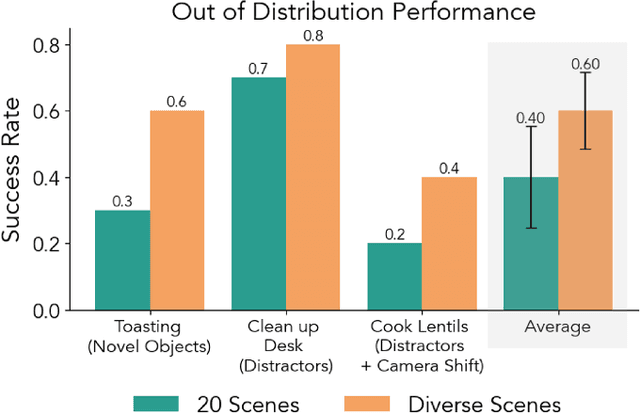
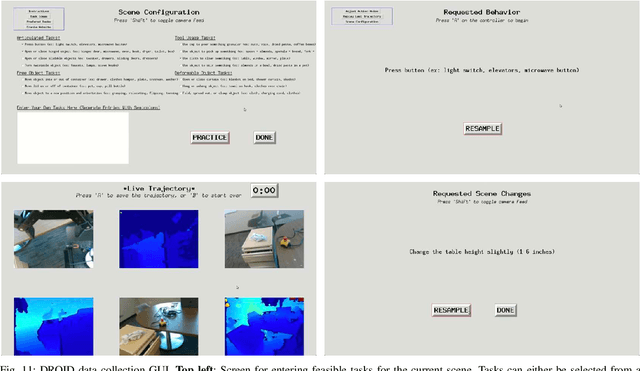
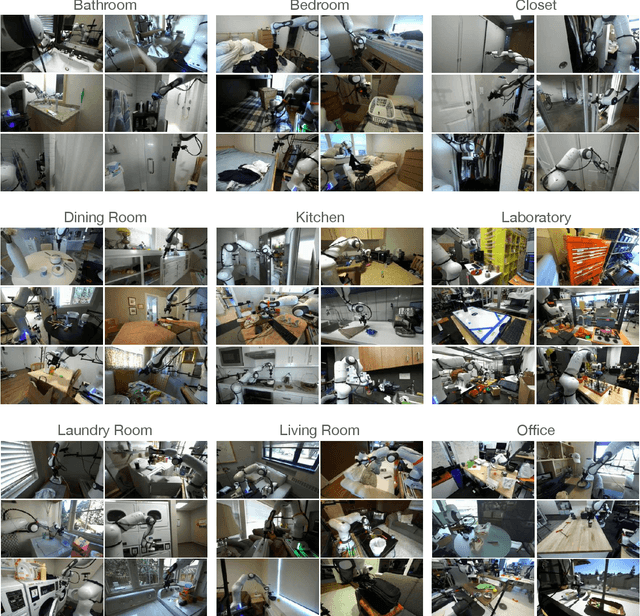
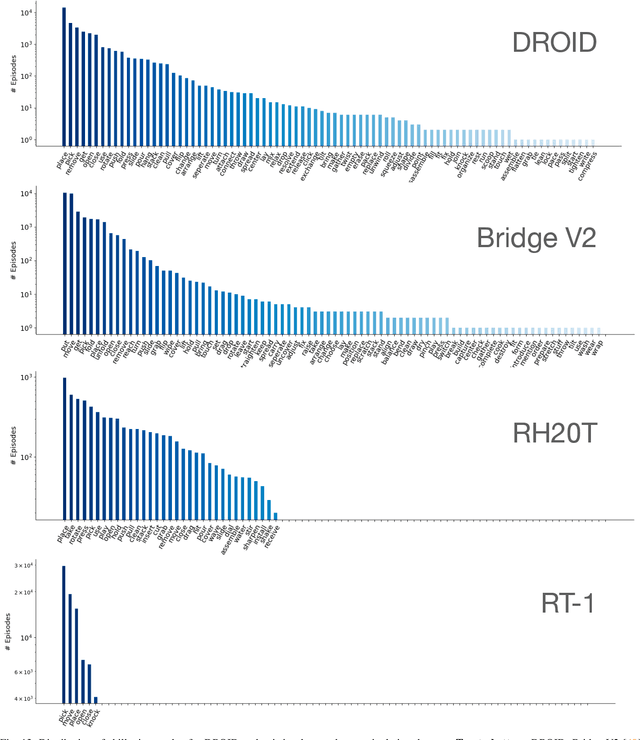
Abstract:The creation of large, diverse, high-quality robot manipulation datasets is an important stepping stone on the path toward more capable and robust robotic manipulation policies. However, creating such datasets is challenging: collecting robot manipulation data in diverse environments poses logistical and safety challenges and requires substantial investments in hardware and human labour. As a result, even the most general robot manipulation policies today are mostly trained on data collected in a small number of environments with limited scene and task diversity. In this work, we introduce DROID (Distributed Robot Interaction Dataset), a diverse robot manipulation dataset with 76k demonstration trajectories or 350 hours of interaction data, collected across 564 scenes and 84 tasks by 50 data collectors in North America, Asia, and Europe over the course of 12 months. We demonstrate that training with DROID leads to policies with higher performance and improved generalization ability. We open source the full dataset, policy learning code, and a detailed guide for reproducing our robot hardware setup.
A Critical Evaluation of AI Feedback for Aligning Large Language Models
Feb 19, 2024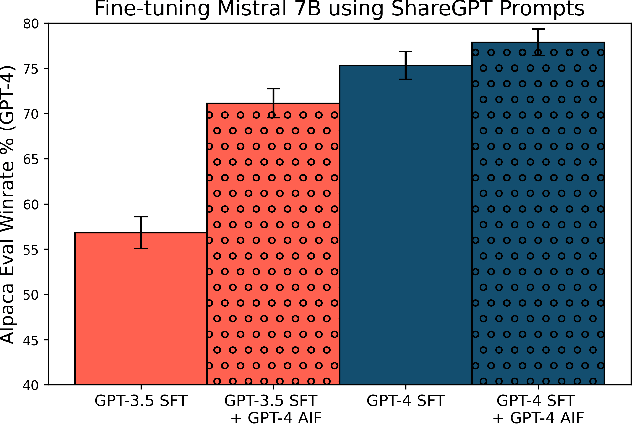

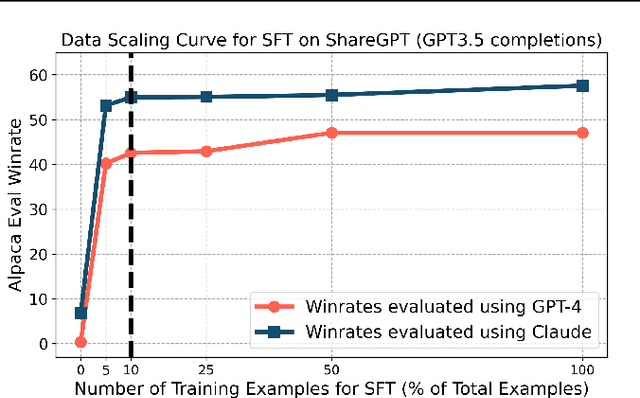
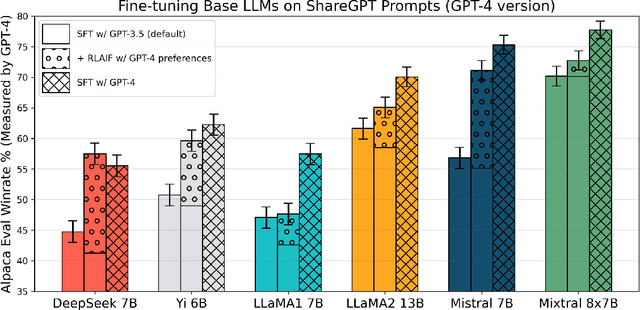
Abstract:Reinforcement learning with AI feedback (RLAIF) is a popular paradigm for improving the instruction-following abilities of powerful pre-trained language models. RLAIF first performs supervised fine-tuning (SFT) using demonstrations from a teacher model and then further fine-tunes the model with reinforcement learning (RL), using feedback from a critic model. While recent popular open-source models have demonstrated substantial improvements in performance from the RL step, in this paper we question whether the complexity of this RL step is truly warranted for AI feedback. We show that the improvements of the RL step are virtually entirely due to the widespread practice of using a weaker teacher model (e.g. GPT-3.5) for SFT data collection than the critic (e.g., GPT-4) used for AI feedback generation. Specifically, we show that simple supervised fine-tuning with GPT-4 as the teacher outperforms existing RLAIF pipelines. More generally, we find that the gains from RLAIF vary substantially across base model families, test-time evaluation protocols, and critic models. Finally, we provide a mechanistic explanation for when SFT may outperform the full two-step RLAIF pipeline as well as suggestions for making RLAIF maximally useful in practice.
 Add to Chrome
Add to Chrome Add to Firefox
Add to Firefox Add to Edge
Add to Edge